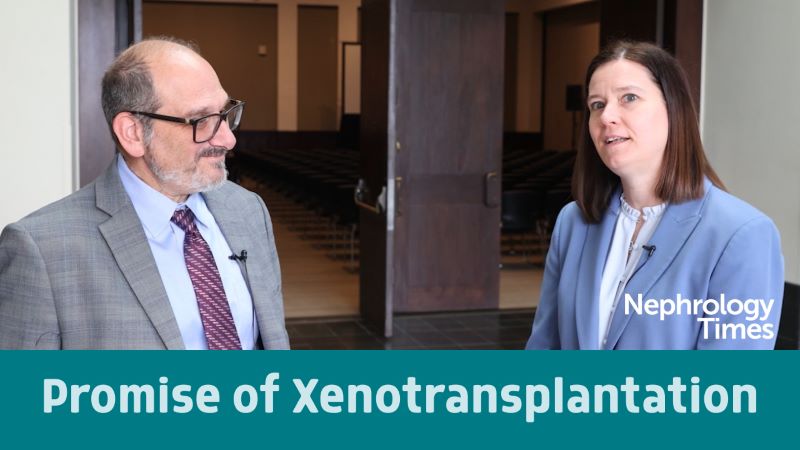
The age-adjusted prevalence of obesity among US adults was 42.4% in 2017 and 2018. Obesity is associated with outcomes and therapeutic options for patients with end-stage renal disease (ESRD). Elevated body mass index (BMI) correlates with several elements of kidney health; it is associated with the presence and emergence of proteinuria in people who do not have a kidney condition, reduced estimated glomerular filtration rate (GFR) and an accelerated decrease in GFR over time, and faster progression of chronic kidney disease (CKD).
However, obesity frequently poses a barrier for patients with ESRD in need of a kidney transplant. Obesity is often considered a contraindication for candidacy based on concerns about compliance, postoperative complications, worsening of comorbidities, and overall patient and graft outcomes.
The national kidney transplantation waiting list illustrates this issue. Data from Scientific Registry of Transplant Recipients records between 2015 and 2020 show that approximately 12% of transplant recipients were categorized as having class III obesity. However, 14% of transplant centers have fewer than 5% of such recipients and just 11% of centers exceed 20%. Moreover, there is a steep decline on the waiting list in patients with a BMI above 40.
To address this issue, Shauna Levy, MD, FACS, and colleagues at Tulane University School of Medicine designed a program in which transplant and metabolic bariatric surgery (MBS) teams collaborated to allow obese patients with ESRD to have weight-loss surgery before obtaining a kidney transplant. Their prospective cohort study followed the outcomes of patients referred to the program. The results were published in the Journal of the American College of Surgeons.
From January 2019 to June 2023, the transplant team referred 183 patients with ESRD to the bariatric team; 115 dropped out. Another 64 (56%) could not complete the workup, 24 (21%) had insurance problems, five (4%) had medical issues that prevented MBS and transplant surgery, and 23 (20%) declined MBS at the start. In total, 36 patients underwent MBS. Most (55.6%) patients had Roux-en-Y gastric bypass (RYGB); 44.4% had sleeve gastrectomy (SG). Patients with a BMI higher than 45 were selected for RYGB due to a greater need for weight loss.
Mean age was 42.9 years (SD: 9.0); there were no significant age differences between the RYGB and SG groups (P=.398). Across the study, 66.7% of participants were female, but gender differences were not statistically significant (P=.406). Of the RYGB group, 75.0% (15) were female; of the SG group, 56.2% (9) were female. In the RYGB group, 60% (12) identified as Black and 40% (8) identified as White.
The primary outcomes were weight loss and improvement in comorbidities relevant to eligibility for transplant. Patients in both the RYGB and SG groups saw a significant decline in BMI. Those in the RYGB group experienced a constant reduction in BMI over 12 months, while the SG group’s stabilized after about 6 months. HbA1c levels also improved, decreasing from 5.4 (interquartile range [IQR], 5.3-6.2) to 4.5 (IQR, 4.4-5.0) for the RYGB group and from 7.0 (IQR, 6.0-8.6) to 5.4 (IQR, 5.2-5.8) for the SG group. Changes were statistically significant for both groups (P=.038 and P=.061, respectively). Both RYGB and SG surgeries helped reduce blood pressure, and there was a median reduction in hypertension medications needed, from two (range, 2-4) presurgery to one (range, 1-3) postsurgery. The RYGB group required fewer medications (median, 1.0; IQR, 0.5-1.5) compared with the SG group (median, 2.0; IQR, 1.0-3.0) postsurgery (P=.189).
The mean starting BMI for all referrals was 46.4 kg/m2, and it was 33.9 kg/m2 at the time of transplant. Regarding transplant surgery, 29 patients were referred following MBS. Four resigned, two were found to be medically unsuitable for transplant, one had an insurance change requiring transplant at a different location, and one received a transplant out of state. Ten had deceased donor transplant, and the remainder are wait-listed.
The mean follow-up after transplant was 15.1 (1.0-36.0) months. During that period, there were no issues of organ rejection or infection and no patient or graft losses. All transplants are currently functioning, with a median creatinine level of 1.5 (1.2-1.6) mg/dL (GFR, 46 [36.3-71.0]).
There were a few limitations to the study. It is difficult to measure compliance after MBS and transplant. Many patients did not complete the protocol, likely due to unpreparedness. The study began before the widespread use of glucagon-like peptide-1 agonist drugs for weight loss, which offer an alternative to MBS.
In summary, the authors view collaboration between bariatric surgery and transplant teams as a pathway to transplant for morbidly obese patients with ESRD who would otherwise be ineligible. They wrote, “With increasing prevalences of obesity and ESRD in this country, we see this as a growing issue. A combined program helps alleviate disparities in health care and transplant access, especially for [Black individuals] and communities with socioeconomic barriers, who are more affected by obesity disease. ESRD patients may have unique complications post-MBS that bear further studies. MBS allows for optimization of patients’ comorbidities, which allows for potential better long-term outcomes post-transplant.”






 © 2025 Mashup Media, LLC, a Formedics Property. All Rights Reserved.
© 2025 Mashup Media, LLC, a Formedics Property. All Rights Reserved.